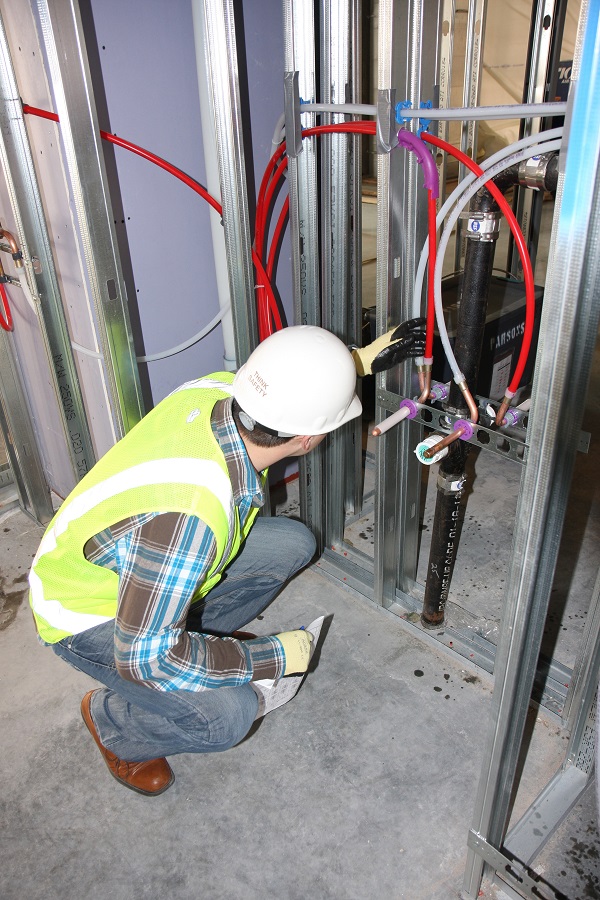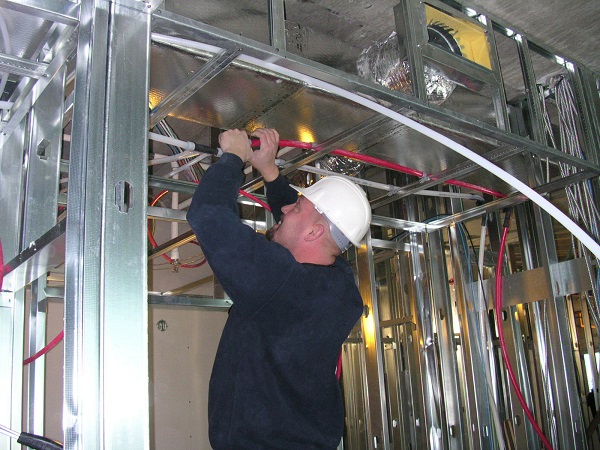Professionals in the commercial trades who have made the switch from copper or CPVC to PEX for plumbing or mechanical piping will tell you there are four main reasons why: speed, cost, reliability and safety. Because in today’s fast paced commercial building environment, change is rapid and inevitable, budgets and schedules are tight, competition is fierce, and skilled labor is shrinking, so keeping valuable employees safe is paramount.
The commercial industry needs a piping solution that can meet all those very important needs, and PEX delivers on every front.
Speed
Because PEX pipe is flexible to bend with each change in direction and the connections are quick to learn and even faster and easier to make, it’s a great solution to meet the skilled-labor shortage challenge and also rapidly accommodate necessary changes in the field.

For example, a PEX piping system in an in-suite multifamily or hospitality project can reduce the number of required fittings by more than half compared to rigid copper or CPVC that require a connection with each change in direction. That can shave days or even weeks off the production schedule, depending on the project size.
Additionally, with today’s aging buildings, PEX is even more beneficial in re pipe applications where existing structures need minimal invasion for renovation (think: historical buildings).
Cost
When it comes to cost, every professional in the commercial world agrees — if the cost is attractive, but the product fails, it’s not worth it. PEX has proven to be both cost-effective and durable, a combination that makes it a win-win for engineers, building owners and installers alike.
Contractors are also finding it’s not just the material costs that are reasonable, it’s also the labor costs that PEX helps manage. Because the flexible pipe requires fewer connections (and those connections are faster and easier to make), it cuts down on labor costs in addition to the bill of material cost for the product.

With materials costing on average up to 30 percent lower than copper, and installs taking up to half the time compared to rigid systems like copper and CPVC, PEX is proving itself to be a smart solution that installers can rely on for consistent pricing, bidding and installations.
Reliability
Every contractor has experienced a leak at one time or another, so a piping material that can help minimize leaks is a huge bonus. Take a look at all the ways PEX helps minimize potential leaks:
- Because the flexible pipe can bend with each change in direction, it reduces the number of fittings and connections and, in turn, the potential for leaks.
- With the PEX cold-expansion fitting system, it is impossible dry fit a connection. The expansion method requires the pipe to first be expanded before inserting a fitting. Then, as the pipe shrinks back down, it creates a strong connection onto the fitting. Eliminating the potential for dry fits means there’s never a concern if the connection is made.
- Flexible PEX is highly resistant to freeze damage because it can expand to accommodate frozen water in the system and then contract back down after the water thaws.
- PEX resists corrosion, pitting and scaling, so there is zero chance of leaks or performance issues due to any of these factors that can plague metallic piping systems.
Safety
With worker safety becoming a bigger issue — especially with the skilled-labor shortage — PEX offers benefits due to its lighter weight. For example, a 300-foot coil of ½-inch PEX weighs about 18 pounds, whereas the same amount of copper pipe weighs around 85 pounds.
Lighter weight means easier maneuvering around the jobsite, less strain on the body and a reduced need for cranes and heavy-lifting equipment.

Also, because all the PEX connection methods (cold expansion, crimp, clamp, compression or push-to-connect) do not need chemicals or open flame, it greatly reduces risk on the job site and also eliminates the need and cost for fire watch requirements.
One last word of advice
Stick with one PEX system brand. Mixing brands for the pipe, fittings, sleeves or rings can greatly reduce (or even void) the warranty. You’ll have more confidence knowing you have the backing of one company if you ever have a service or warranty issue.
If you’re interested in learning more about PEX pipe and fitting systems, visit the Plastics Pipe Institute website at plasticpipe.org or the Plastic Pipe and Fittings Association website at ppfahome.org.
 Kim Bliss is the content development manager at Uponor. She can be reached at kim.bliss@uponor.com.
Kim Bliss is the content development manager at Uponor. She can be reached at kim.bliss@uponor.com.




Join the conversation: